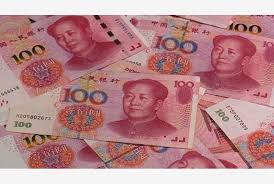
Consumer prices fell 0.2% on the month in June, shocking analysts on the downside and leaving the annual CPI at zero. The annual fall in producer prices of 5.4% was the worst since late 2015.
This suggests there is a lot of room to further relax monetary and fiscal policy, on the surface. But it also highlights how difficult it will be for Beijing to prevent a full-fledged deflationary spiral. The example of Japan demonstrates the effects of deflation and population decline on an economy.
The yuan lost some of its early gains as a result of the weaker statistics, but Chinese blue chips are still up, in part because of expectations that Beijing may loosen its regulatory restrictions on the IT industry.
Globally, a deflationary surge from China could eventually assist to balance inflation brought on by services in rich countries. One of the main reasons economists anticipate upcoming U.S. CPI data to show a slowdown in June is disinflation in goods.
Headline Even though core measurements are proving to be stickier, the U.S. inflation rate is predicted to fall to 3.1%, a notable improvement from 9.1% a year earlier. After its recent beating, the Treasury market might appreciate hearing that.
Some funds plainly had bonds on their portfolios in anticipation of the "end of the tightening cycle" rally, which never occurred. As a result, they suffered significant losses when the market turned against them.
Despite the adverse miss on headline payrolls, U.S. 10-year rates are still touching 4.09%, which shows that the market is still long and that there is still more pain to come.
Carry transactions in the currency market have been eliminated as a result of the rise in bond yields. The Mexican peso is probably the most crowded of all the transactions, with every investor and their mother having borrowed cheaply in yen to invest in high yielders.
Rising yields in the developed world can put pressure on those investments by making emerging economies appear relatively less appealing. Despite months of increases, it was remarkable late last week when Mexican bonds abruptly began to fall in value and the peso fell 2.6% against the yen over two sessions.
When the positions are reversed, it results in the sale of dollars for yen because such trades are often conducted by selling yen for dollars and dollars for pesos, or whatever the target currency is.
This was probably a big factor in the dollar's 1.3% decline against the yen on Friday, and it also explains why any significant unwinding of carry trades would cause the dollar to decline even if its own fundamentals were strong.
However, until and until the Bank of Japan ultimately abandons its yield curve control (YCC) policy, a protracted unwinding appears improbable.
On July 28, the BOJ will hold its next meeting, and many western banks are predicting more tightening, even if the BoJ itself has not showed many signs of agreeing with them. It would be a major market event if it happened.
(Source:www.reuters.com)
This suggests there is a lot of room to further relax monetary and fiscal policy, on the surface. But it also highlights how difficult it will be for Beijing to prevent a full-fledged deflationary spiral. The example of Japan demonstrates the effects of deflation and population decline on an economy.
The yuan lost some of its early gains as a result of the weaker statistics, but Chinese blue chips are still up, in part because of expectations that Beijing may loosen its regulatory restrictions on the IT industry.
Globally, a deflationary surge from China could eventually assist to balance inflation brought on by services in rich countries. One of the main reasons economists anticipate upcoming U.S. CPI data to show a slowdown in June is disinflation in goods.
Headline Even though core measurements are proving to be stickier, the U.S. inflation rate is predicted to fall to 3.1%, a notable improvement from 9.1% a year earlier. After its recent beating, the Treasury market might appreciate hearing that.
Some funds plainly had bonds on their portfolios in anticipation of the "end of the tightening cycle" rally, which never occurred. As a result, they suffered significant losses when the market turned against them.
Despite the adverse miss on headline payrolls, U.S. 10-year rates are still touching 4.09%, which shows that the market is still long and that there is still more pain to come.
Carry transactions in the currency market have been eliminated as a result of the rise in bond yields. The Mexican peso is probably the most crowded of all the transactions, with every investor and their mother having borrowed cheaply in yen to invest in high yielders.
Rising yields in the developed world can put pressure on those investments by making emerging economies appear relatively less appealing. Despite months of increases, it was remarkable late last week when Mexican bonds abruptly began to fall in value and the peso fell 2.6% against the yen over two sessions.
When the positions are reversed, it results in the sale of dollars for yen because such trades are often conducted by selling yen for dollars and dollars for pesos, or whatever the target currency is.
This was probably a big factor in the dollar's 1.3% decline against the yen on Friday, and it also explains why any significant unwinding of carry trades would cause the dollar to decline even if its own fundamentals were strong.
However, until and until the Bank of Japan ultimately abandons its yield curve control (YCC) policy, a protracted unwinding appears improbable.
On July 28, the BOJ will hold its next meeting, and many western banks are predicting more tightening, even if the BoJ itself has not showed many signs of agreeing with them. It would be a major market event if it happened.
(Source:www.reuters.com)





